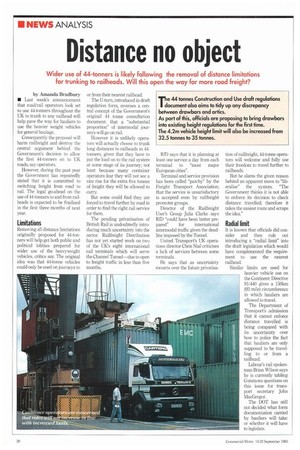Distance no object
Page 22

If you've noticed an error in this article please click here to report it so we can fix it.
by Amanda Bradbury • Last week's announcement that road/rail operators look set to use 44-tanners throughout the UK to trunk to any railhead will help pave the way for hauliers to use the heavier weight vehicles for general haulage.
Consequently the proposal will harm railfreight and destroy the central argument behind the Government's decision to allow the first 44-tonners on to UK roads, say operators.
However, during the past year the Government has repeatedly stated that it is committed to switching freight from road to rail. The legal go-ahead on the use of 44-tormers to and from railheads is expected to be finalised in the first three months of next year.
Removing all distance limitations originally proposed for 44-tonners will help get both public and political lobbies prepared for wider use of the heavyweight vehicles, critics say. The original idea was that 44-tonne vehicles could only be used on journeys to or from their nearest railhead.
The U-turn, introduced in draft regulation form, reverses a central concept of the Government's original 44 tonne consultation document: that a "substantial proportion" of intermodal journeys will go on rail.
However it is unlikely operators will actually choose to trunk long distances to railheads in 44tonners, given that they have to put the load on to the rail system at some stage of its journey; not least because many container operators fear they will not see a rate rise for the extra five tonnes of freight they will be allowed to carry.
But some could find they are forced to travel further by road in order to find the right rail service for them.
The pending privatisation of British Rail is undoubtedly introducing much uncertainty into the sector. Railfreight Distribution has not yet started work on two of the UK's eight international rail terminals which will serve the Channel Tunnel—due to open to freight traffic in less than live months.
RID says that it is planning at least one service a day from each terminal to "most major European cities".
Terminal and service provision has been called "patchy" by the Freight Transport Association; that the service is unsatisfactory is accepted even by railfreight promoter groups.
Director of the Railfreight User's Group Julia Clarke says RfD "could have been better pre pared" for international intermodal traffic given the deadline imposed by the Tunnel.
United Transport's UK operations director Chris Nial criticises a lack of services between some terminals,
He says that as uncertainty mounts over the future privatisa
tion of railfreight, 44-tonne operators will welcome and fully use their freedom to travel further to railheads.
But he slams the given reason behind an apparent move to "liberalise" the system. "The Government thinks it is not able to enforce its decision to check distance travelled; therefore it takes the easiest route and scraps the idea"
It is known that officials did consider and then rule out introducing a "radial limit" into the draft legislation which would have complemented the requirement to use the nearest railhead.
Similar limits are used for heavier vehicle use on the Continent: Directive 91/4.40 gives a 150km (93 mile) circumference in which hauliers are allowed to travel.
The Department of Transport's admission that it cannot enforce distance travelled is being compared with its uncertainty over how to police the fact that hauliers are only supposed to be travelling to or from a railhead.
Labour's rail spokesman Brian Wilson says he is currently tabling Commons questions on this issue for transport secretary John MacGregor.
The DOT has still not decided what form documentation carried by hauliers will take: or whether it will have to legislate.


























































































